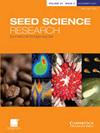(Epi)genetic control of secondary seed dormancy depth and germination in Capsella bursa-pastoris
IF 1.9
3区 生物学
Q2 PLANT SCIENCES
引用次数: 0
Abstract
Abstract Despite the importance of secondary dormancy for plant life cycle timing and survival, there is insufficient knowledge about the (epigenetic) regulation of this trait at the molecular level. Our aim was to determine the role of (epi)genetic processes in the regulation of secondary seed dormancy using natural genotypes of the widely distributed Capsella bursa-pastoris. Seeds of nine ecotypes were exposed to control conditions or histone deacetylase inhibitors [trichostatin A (TSA), valproic acid] during imbibition to study the effects of hyper-acetylation on secondary seed dormancy induction and germination. Valproic acid increased secondary dormancy and both compounds caused a delay of t50 for germination (radicle emergence) but not of t50 for testa rupture, demonstrating that they reduced speed of germination. Transcriptome analysis of one accession exposed to valproic acid versus water showed mixed regulation of ABA, negative regulation of GAs, BRs and auxins, as well as up-regulation of SNL genes, which might explain the observed delay in germination and increase in secondary dormancy. In addition, two accessions differing in secondary dormancy depth (deep vs non-deep) were studied using RNA-seq to reveal the potential regulatory processes underlying this trait. Phytohormone synthesis or signalling was generally up-regulated for ABA (e.g. NCED6, NCED2, ABCG40, ABI3) and down-regulated for GAs (GA20ox1, GA20ox2, bHLH93), ethylene (ACO1, ERF4-LIKE, ERF105, ERF109-LIKE), BRs (BIA1, CYP708A2-LIKE, probable WRKY46, BAK1, BEN1, BES1, BRI1) and auxin (GH3.3, GH3.6, ABCB19, TGG4, AUX1, PIN6, WAT1). Epigenetic candidates for variation in secondary dormancy depth include SNL genes, histone deacetylases and associated genes (HDA14, HDA6-LIKE, HDA-LIKE, ING2, JMJ30), as well as sequences linked to histone acetyltransferases (bZIP11, ARID1A-LIKE), or to gene silencing through histone methylation (SUVH7, SUVH9, CLF). Together, these results show that phytohormones and epigenetic regulation play an important role in controlling differences in secondary dormancy depth between accessions.(Epi)对毕赤酵母二次种子休眠深度和发芽的遗传控制
摘要尽管二次休眠对植物生命周期的时间安排和生存很重要,但在分子水平上对该性状的(表观遗传学)调控知之甚少。我们的目的是利用广泛分布的毕赤酵母的天然基因型来确定(epi)遗传过程在调节二次种子休眠中的作用。将9种生态型的种子在吸胀过程中暴露于对照条件或组蛋白脱乙酰酶抑制剂[Ttrichostatin A(TSA),丙戊酸],以研究超乙酰化对种子二次休眠诱导和发芽的影响。丙戊酸增加了二次休眠,两种化合物都导致发芽(胚根出苗)的t50延迟,而种皮破裂的t50没有延迟,这表明它们降低了发芽速度。暴露于丙戊酸与水的一个登录的转录组分析显示ABA的混合调节,GA、BR和生长素的负调节,以及SNL基因的上调,这可能解释了观察到的发芽延迟和次生休眠增加。此外,使用RNA-seq研究了两种次生休眠深度不同的材料(深休眠与非深休眠),以揭示这一特性的潜在调控过程。植物激素合成或信号传导通常对ABA(例如NCED6、NCED2、ABCG40、ABI3)上调,对GA(GA20ox1、GA20ox2、bHLH93)、乙烯(ACO1、ERF4-LIKE、ERF105、ERF109-LIKE)、BR(BIA1、CYP708A2-LIKE,可能的WRKY46、BAK1、BEN1、BES1、BRI1)和生长素(GH3.3、GH3.6、ABCB19、TGG4、AUX1、PIN6、WAT1)下调。次级休眠深度变化的表观遗传学候选者包括SNL基因、组蛋白脱乙酰酶和相关基因(HDA14、HDA6-LIKE、HDA-LIKE、ING2、JMJ30),以及与组蛋白乙酰转移酶(bZIP11、ARID1A-LIKE)或通过组蛋白甲基化的基因沉默(SUVH7、SUVH9、CLF)相关的序列。总之,这些结果表明,植物激素和表观遗传调控在控制材料间次生休眠深度差异方面发挥着重要作用。
本文章由计算机程序翻译,如有差异,请以英文原文为准。
求助全文
约1分钟内获得全文
求助全文
来源期刊

Seed Science Research
生物-植物科学
CiteScore
3.60
自引率
4.80%
发文量
23
审稿时长
>12 weeks
期刊介绍:
Seed Science Research, the official journal of the International Society for Seed Science, is a leading international journal featuring high-quality original papers and review articles on the fundamental aspects of seed science, reviewed by internationally distinguished editors. The emphasis is on the physiology, biochemistry, molecular biology and ecology of seeds.
 求助内容:
求助内容: 应助结果提醒方式:
应助结果提醒方式:


